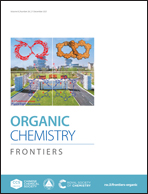Mechanisms and origins of regioselectivities of nickel-catalyzed β,δ-vinylarylation of alkenyl esters with vinyl triflates and arylzinc reagents†
Abstract
The mechanisms and origins of regioselectivity in the β,δ-vinylarylation of alkenyl esters with vinyl triflates and arylzinc reagents catalyzed by nickel catalysts were systematically explored using density functional theory calculations to focus on revealing whether the remote difunctionalization of γ,δ-alkenyl α-cyanocarboxylic esters proceeds via the coordination of an ester group. The calculations indicate that the ester group only coordinates to Ni during the oxidative addition step, which is significantly different from the commonly accepted mechanism, which involves the contraction of six-membered nickellacycles to afford five-membered nickellacycles. The origin of the regioselectivity is attributed to the β,δ-vinylarylation pathway not involving the formation of the unstable high oxidation state Ni(III) species in the phenyl migration step and encountering less steric hindrance in the oxidative addition step. The Ni–π and π–π interactions were found to account for the experimentally observed substituent-controlled reactivity.



 Please wait while we load your content...
Please wait while we load your content...